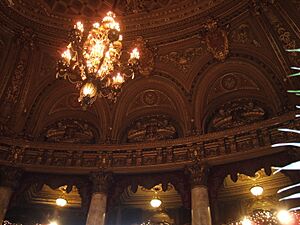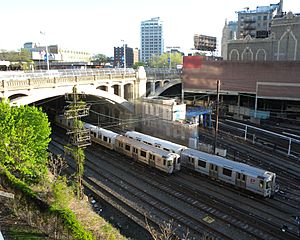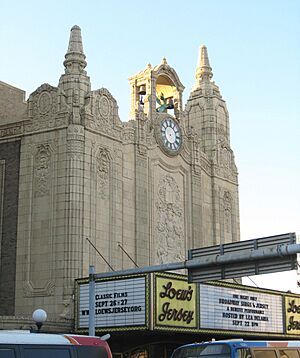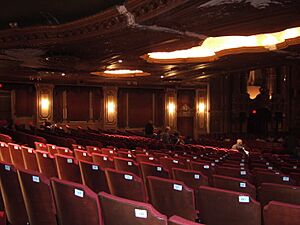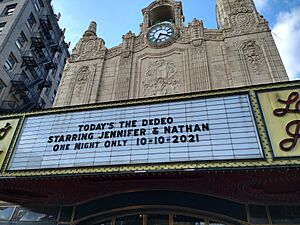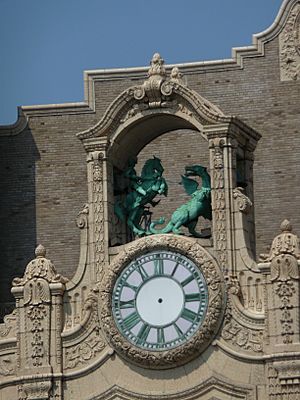Loew's Jersey Theatre facts for kids
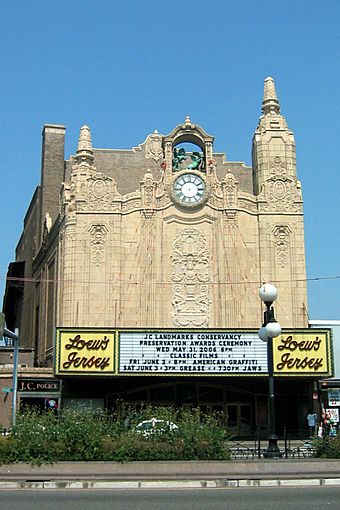
The facade as seen in 2006
|
|
| Address | 54 Journal Square Jersey City, New Jersey United States |
|---|---|
| Coordinates | 40°43′56″N 74°3′52″W / 40.73222°N 74.06444°W |
| Public transit | Journal Square Transportation Center |
| Owner | Government of Jersey City |
| Operator | Harris Blitzer Sports & Entertainment (HBSE) |
| Type | Movie palace |
| Capacity | At least 3,021 |
| Current use | Entertainment venue |
| Construction | |
| Opened | September 28, 1929 |
| Closed | August 21, 1986 (as movie palace) |
| Rebuilt | 1986–2001, 2021–present |
| Years active | 1929–1986 (as movie palace), 2001–present (as event venue) |
| Architect | Rapp and Rapp |
|
Loew's Jersey Theatre
|
|
| Location | 54 Journal Square, Jersey City, New Jersey, U.S. |
| Architectural style | Late 19th & 20th Century Revivals; Baroque Revival |
| NRHP reference No. | 100007648 |
| Significant dates | |
| Added to NRHP | April 25, 2022 |
The Loew's Jersey Theatre is a famous cinema and performance hall. It is located at 54 Journal Square in Jersey City, New Jersey, USA. The theater was designed by Rapp and Rapp to be a grand movie palace. It first opened on September 28, 1929. It was one of five special "Loew's Wonder Theatres" built in the New York City area. The government of Jersey City owns the Loew's Jersey. Since 2021, Harris Blitzer Sports & Entertainment (HBSE) has managed it. The theater is listed on both the New Jersey Register of Historic Places and the National Register of Historic Places. This means it is a very important historical building.
The Loew's Jersey Theatre has a unique shape and is split into two main parts: the lobby and the auditorium. The front of the lobby has a fancy terracotta design. It features a large marquee, a special Seth Thomas clock, and a sculpture of Saint George fighting a dragon. Inside, the entrance leads to a beautiful lobby with high ceilings. There are also several other rooms and lounges. The main auditorium has over 3,021 seats on two levels. It has a richly decorated proscenium arch, walls, and ceilings. Like the other Wonder Theatres, the Loew's Jersey had a special pipe organ. The organ used today came from the Paradise Theater in the Bronx, New York.
Loew's Theatres started planning this theater in Journal Square in 1927. The Loew's Jersey originally showed movies and live stage shows. The live shows stopped in 1935. After World War II, the theater became less popular. It mostly showed only movies. In 1974, it was changed into a triplex cinema with three screens. The theater closed in August 1986. A company called Hartz Mountain Industries bought it and planned to tear it down. But people who wanted to save the theater formed a group called Friends of the Loew's (FOL). They started fixing up the theater after Jersey City's government bought it in 1993. The theater partly reopened for shows in 2001. After trying to find a new manager for a while, Jersey City officials leased the theater to HBSE in early 2021. HBSE closed the theater later that year for a big renovation. This renovation is expected to be finished in 2026.
Contents
Exploring the Loew's Jersey Theatre
The Loew's Jersey Theatre is at 54 Journal Square in Jersey City, New Jersey. It is on the west side of Kennedy Boulevard, near the Journal Square Transportation Center. The theater has two main parts: the lobby in the front and the auditorium in the back. The PATH train tracks run just north of the theater. An alley called Journal Square Concourse West is to the south. The theater is surrounded by other buildings like Journal Squared and One Journal Square.
The famous firm of Rapp and Rapp designed the Loew's Jersey. The theater's style is often called Spanish Baroque or Italian rococo. It was one of five "Loew's Wonder Theatres" in the New York City area. It was the only one outside New York City itself. The other Wonder Theatres were the Paradise Theatre in the Bronx, the 175th Street Theatre in Manhattan, the Valencia Theatre in Queens, and the Kings Theatre in Brooklyn. The Loew's Jersey was also one of three big movie theaters in Journal Square. The others were the State Theatre and the Stanley Theatre.
The Theater's Outside Look
Front of the Building
The main front of the theater faces east toward Journal Square. It is covered in cream-colored terracotta. The front is divided into a fancy central part and two simpler side parts. You enter the lobby through a wide doorway. The doors are set back a little, and a bronze ticket booth sticks out in the middle. Above the doorway is a curved window. The original marquee (the sign over the entrance) was curved. It was replaced in 1949 with a rectangular sign. In 2024, this marquee was replaced again with a modern LED sign.
To the right of the main entrance is a black-marble exit door. To the left is a small shop area. Above the marquee, the central part of the building is decorated with urns, flowers, fruit, and cherubs. On top of this is a large clock made by the Seth Thomas Clock Company. It is about 10 by 12 feet (3.0 by 3.7 m) big. There is also a special arch with moving figures of Saint George fighting a dragon. These bronze figures are 6 feet (1.8 m) tall. The dragon's mouth could move and had a red light inside. Every fifteen minutes, a 550-pound (250 kg) bell rang. The dragon's mouth would open, and Saint George would raise his sword. A separate 250-pound (110 kg) bell rang every hour.
The central and side parts of the building are separated by pilasters (flat columns) with grooves. The side parts have terracotta frames with mask-like faces at the top. A decorative band runs across the top of the front. Both side parts have fancy tops with urns and tall spires. The one on the right is taller. Behind the front entrance is the auditorium's wall, made of light brown brick. The top of this wall has a terracotta decoration that rises to a round design in the middle. There is also a chimney on the south side.
Other Sides of the Building
The north side of the theater, facing a department store, is made of light brown brick with terracotta decorations. The lobby section on this side has three arched terracotta panels. Above these panels is a terracotta band with a round design in the middle. The auditorium section also has three arched terracotta panels, each topped with shields and leaves. There are pilasters between these panels. Above the auditorium's north side is another terracotta band with shields and a stepped top, similar to the front.
The south and west sides of the building are simpler. The south side is made of light brown brick and faces an alley. The west side is made of red brick and faces a cul-de-sac. On the south side, the lower part is covered in stucco. There is a terracotta trim and a setback (a step back in the wall) above the ground-floor shops. The upper parts of the south side have a terracotta panel, while the rest is plain brick. The west side and the western part of the south side are similar, but with red brick. There are several doors at ground level, a decorative band above them, and a fire escape with a cover.
Inside the Theater
When the theater opened, its inside was described as being in the Italian Baroque style. It had many expensive and rare art pieces from Europe. These included furniture, bronze statues, paintings, and clocks from England, France, Germany, and Italy. The theater also had an air-conditioning system that cooled the whole building. Loew's said that visiting the theater was "equal to a trip to the mountains, sea or country."
Vestibule and Lobby
The main entrance leads to a vestibule. Its walls are made of white and black marble. The vestibule has plaster decorations on the ceiling and walls, with flowers and medallions. The east wall has glass doors from the entrance, and the west wall has similar doors leading to the main lobby. There were originally two marble ticket booths, but only the south one remains. There are also doorways leading to an exit passage and the theater's offices.
The main lobby is oval-shaped and decorated in gold and gray, with blue and red touches. It has many fancy designs like medallions, cherubs, faces, and floral patterns. The floor is covered with carpets. The center of the lobby has columns in the Corinthian order (a fancy Greek style). The lower parts of the walls have marble panels. The ceiling is a dome that rises three stories high. A huge bronze and crystal chandelier hangs from the center of the ceiling. It cost $60,000 to put in.
Two curving staircases lead from the lobby to a mezzanine (a middle floor). The stairs have white marble posts and bronze railings. The mezzanine is behind the columns and has a bronze railing. Its outer walls have fabric panels and mirrors. The ceiling has gold-colored medallions. This area originally had velvet furniture. At the east end of the mezzanine is the music gallery. It has a domed ceiling and fancy plaster decorations. It once held a piano, china, paintings, and figures.
Foyers and Lounges
The lobby's ground floor connects to the orchestra-level foyer (a waiting area) to the west. This area had red carpets, marble walls, and gold-colored columns. It also had an old French clock. Doors lead from here to the basement and the auditorium.
The mezzanine foyer, just above the orchestra foyer, has a red carpet and blue walls with red fabric panels. It used to have a pool with live goldfish, which was removed in 1974. This pool was surrounded by gold and green tiles. Doors from this foyer lead to the theater's lounges and restrooms. The ceiling has plaster medallions and gold and green decorations.
Next to the mezzanine foyer are separate rooms for men and women. Both areas have a restroom, a washroom, and a lounge. The women's area also has an octagonal room for makeup. The men's lounge is in the Elizabethan style with a wooden fireplace. The restrooms have tile floors and walls. The women's lounge has a marble fireplace and wooden panels.
Staircases from the mezzanine lead up to a balcony-level foyer. This foyer leads to the upper part of the auditorium's balcony. The staircases have bronze railings and fabric-covered walls. The balcony foyer walls have gold borders and velvet curtains.
Auditorium Design
The auditorium originally had between 3,021 and 3,600 seats. The seats are on a lower orchestra level and an upper balcony level. All seats face the stage to the west. The balcony is at the east end of the auditorium and is split into two sections. There are two projection booths behind the orchestra seats. These were added in the 1970s when the orchestra level was divided into two screening rooms. Behind the balcony was a room for the press. Battisti Studios did much of the interior design.
The auditorium has plaster decorations covered with gold leaf. It is decorated with murals, Greek cross patterns, and gold panels. These decorations were designed to help sound spread evenly. A special chemical was put on the walls and ceiling for good sound. On the balcony level, the north and south walls have three large arches. These arches have red-velvet curtains with gold fringes and decorated canopies. Behind the curtains are colorful lights. The front of the lower balcony has a gold-colored railing with plaster decorations. The ceiling was painted blue with ivory and gold leaf. A ten-tiered chandelier with bronze and crystals lit the auditorium. Its lights could change color to match the sound films being shown.
On the west wall of the auditorium is the proscenium arch, which frames the stage. This arch is decorated with marble panels and designs. On each side of the arch is an organ loft with four decorated columns. Velvet curtains hang from these lofts. The current movie screen, inside the arch, is 25 by 50 feet (7.6 by 15.2 m) and was put in in 2002. The stage is about 33 by 72 feet (10 by 22 m) or 35 by 75 feet (11 by 23 m). The orchestra pit in front of the stage could hold 45 musicians. There is a fly system about 80 feet (24 m) above the stage for moving scenery. There are also lifts under the stage and orchestra pit.
Backstage, workers could get sets ready for up to ten live acts. The basement originally had rehearsal and storage areas, plus 50 dressing rooms. The dressing rooms were along the edges of the basement. The center of the basement had a trap room (under the stage) and storage rooms. There was a hallway for performers to get to the orchestra lift. Under the seating areas was a space for the ventilation system. The east end of the basement had rooms for ushers.
The Theater Organ
Like the other Wonder Theatres, the Loew's Jersey Theatre has a "Wonder Morton" pipe organ. It was made by the Robert Morton Organ Company. The organ has a console with 4 keyboards and 23 sets of pipes. The Jersey's first organ was taken out in 1949. It was moved to the Arlington Theatre in Santa Barbara, California, in 1986.
The organ used today was actually meant for the Jersey, but it was first put in the Paradise Theatre by mistake. After being removed from the Paradise, it was sold several times. It ended up in Kansas City, Missouri. In 1997, the organ was moved to the Jersey Theatre. It was officially played again in 2007. This organ is known as the Bob Balfour Memorial Wonder Morton. It is the only Wonder Morton organ still used in a Wonder Theatre. It has about 1,678 or 1,799 pipes. Like the original, it has 4 keyboards and 23 sets of pipes. It can also make sound effects like thunder and car horns. The pipes are in the organ lofts and range from 5 inches (130 mm) to 16 feet (4.9 m) tall. Air flows into the pipes from large ducts. To play the organ, the operator presses foot pedals that control the air flow.
History of the Loew's Jersey Theatre
Movie palaces became popular in the 1920s. In the New York City area, only a few companies built these grand theaters. By the late 1920s, many movie palaces were built in neighborhoods outside of Midtown Manhattan. The five Wonder Theatres were built by Loew's Inc. In 1927, Loew's president Nicholas Schenck agreed to take over five sites from another company. These five sites became the Wonder Theatres.
Building and Opening
In 1922, the Pennsylvania Railroad sold some empty land near the PATH's Journal Square station. This land was known as "the bowl." A businessman named Henry S. Kerbaugh bought the land. In 1925, Kerbaugh announced plans for a garage and showroom there. This plan grew into a $3 million project for a theater and a 16-story office building. But the city did not approve a new road, so the project stalled.
By 1927, Loew's was planning a theater near Journal Square. The location was chosen because it was easy to see and close to the train station. The theater was originally planned for Staten Island, New York. It was designed with a 17-story hotel. In mid-1927, Loew's got permission to remove part of a nearby bridge to build the theater. However, the architects, Rapp and Rapp, could not finish their plans on time. Because talking films were becoming popular, the theater was redesigned to work well with sound movies. This included making the auditorium sound better. In early 1928, a construction permit was given for a 4,000-seat Loew's theater. In July, Loew's gave a $3 million construction contract to Masem Construction Company. The theater was almost finished by April 1929.
Loew's placed many advertisements in The Jersey Journal before the theater opened. The theater opened on September 28, 1929. Its first film was Madame X. The Jersey Theatre was the third Wonder Theatre to open that month. It cost $2 million to build. It was the first movie theater in New Jersey built specifically for sound films. The opening included performances by local musicians and actor George K. Arthur. Ben Black was the first master of ceremonies, Leo Weber was the first organist, and George Dumond was the first manager.
How the Theater Operated
When it opened, the Loew's Jersey showed new films from United Artists and Metro-Goldwyn-Mayer. It also showed newsreels, short films, and live stage shows. These stage shows had already been performed at the Capitol Theatre in Manhattan. New films were shown at the Loew's Jersey before any other theater in New Jersey. The stage shows moved from the Capitol Theatre to the Loew's Paradise, Kings, Valencia, and then Jersey theaters. In its early years, the Jersey City Theater hosted films, dance shows, vaudeville, graduation ceremonies, and contests. Tickets originally cost 25 cents for front-row seats and 20 cents for others. A new show was presented every week. The theater showed many different films, from Gone with the Wind (1939) to Howard the Duck (1986). The Loew's Jersey was a popular place for couples in North Jersey.
The Early Years (1920s to 1940s)
The orchestras at the Jersey City theatre and other Loew's theaters started performing at different Loew's theaters in late 1929. Loew's also held competitions on the Jersey City Theatre's stage. The theater broadcast weekly music performances on the radio. In 1930, Loew's installed a wide screen at the Jersey City Theatre. Jersey City mayor Frank Hague organized a big celebration for the theater's first anniversary. The Bayonne Times reported that the theater was often full. In 1931, the theater's stage shows were changed to open on Fridays. By then, the Jersey City Theatre was one of the few Loew's theaters that still had vaudeville shows. A snack bar was added around the early 1930s. The theater had over a million visitors each year in the 1930s, staying popular even during the Great Depression.
Loew's started hosting five-act vaudeville shows at the Jersey in 1932. The 1933 season included performances by Bob Hope, Bing Crosby, Bojangles Robinson, and Milton Berle. Some say Frank Sinatra decided to become a singer after seeing one of Crosby's shows there. The theater hosted an even bigger stage show for its fifth anniversary in 1934. It featured actors George Jessel and Jackie Cooper. Loew's stopped hosting live shows at the Jersey City Theatre in August 1935. They switched to showing only films. This was because the company was removing vaudeville shows from most of its theaters. The film China Seas was shown that same month. It was the first time a film had been shown at the Loew's Jersey Theatre for more than a week. Film screenings continued to attract large crowds into the late 1930s.
The Loew's Jersey sold war bonds for the US military during World War II. It might have also had live shows briefly during the war. It hosted symphony concerts every Sunday until 1945 and an annual beauty contest. After the manager, George Dumond, retired in 1945, James Kolbeck took over. Under Kolbeck, the theater was renovated. For example, the orchestra pit and the original organ were covered in 1949. This was because the theater no longer had live shows. A new movie screen was installed the same year. A new marquee and air-conditioning system were also added in 1949. One manager later said the air conditioning helped bring more people in during the summer.
Later Years (1950s to early 1980s)
After a 1948 court ruling, Loew's Theaters had to separate its film-making and film-showing businesses. William Analante became the theater's manager. In 1953, a large 1,000-square-foot (93 m2) panoramic screen was installed. New lenses and projectors were also added. The number of visitors dropped by 50% in the decades after World War II. By the 1960s, Loew's Theaters Inc. was having money problems. The chain closed some of its bigger theaters because they were too expensive to run. Also, people were moving to the suburbs. Neighborhood movie theaters had to compete with shopping-mall multiplexes and home televisions. So, visitor numbers went down in the 1960s, but the Jersey Theatre stayed open.
In the mid-1960s, Loew's let antique dealers remove the theater's art for safekeeping. The Loew's Jersey started hosting events like a televised boxing match in 1964. It also began showing multiple new films at the same time. During this decade, the tall sign on the front of the theater was removed. The auditorium's sound system was also improved. The lobby was renovated in 1965 with new tiles, lighting, and carpet. The theater hosted its last stage concert of the 20th century in 1968. It celebrated its 40th anniversary the next year. The Loew's Jersey also started showing Greek-language films once a week in 1970.
In 1974, the theater was split into three screening rooms. This project closed the theater for four months. Two 524-seat screening rooms were made on the orchestra level. The balcony was turned into a third, larger screening room with 1,078 seats. Many seats were removed, but most of the decorations stayed. The original organ was also removed. The stage was sealed off, and new air vents were added. When the theater reopened in December 1974, it was the first triplex theater in North Jersey. After this change, the Loew's Jersey first saw more visitors. By the early 1980s, there was more petty crime in Journal Square. Police officers patrolled the theater daily. Also, there was more competition from other multiplex cinemas in North Jersey. Soon, many of the theater's remaining visitors were groups of teenagers.
Theater Closure
In early 1984, Jersey City's City Council approved a study to see if the area around the Loew's Jersey Theatre should be called a "blighted area." This would allow the city government to buy property there. Loew's and a local developer, Hartz Mountain Industries, planned to replace the theater with two office towers. The plans included shops, parking garages, and a connection to the Journal Square PATH station. Before this could happen, the city government held public meetings. People who wanted to save the theater asked the city to make the building a landmark. The city's planning board suggested calling the site blighted, and the City Council agreed in September 1984.
The theater was added to the New Jersey Register of Historic Places on August 15, 1985. The owners did not want it listed. It was also eligible for the National Register of Historic Places (NRHP), but it was not listed then because the owners objected. Hartz Mountain bought the theater for about $1.5 million in early 1986. By then, the Saint George and dragon figures on the front had been broken for several years. The theater closed on August 21, 1986. The last films shown were Friday the 13th Part VI: Jason Lives and One Crazy Summer. After the theater closed, the city government thought about making Hartz keep the theater's front and lobby. Hartz first agreed to this. The theater was named a Jersey City landmark, but the City Council needed to pass a resolution for it to have legal effect.
Saving and Restoring the Theater
The 1980s and 1990s
Plans to Tear Down the Theater
The week after the theater closed, the National Endowment for the Arts offered a $10,000 grant to help save it. This grant required the local community to raise the same amount. By January 1987, Hartz no longer wanted to save the theater. Instead, they asked for permission to tear it down. A state judge said no to Hartz's request, so Hartz sued the Jersey City government. Two local groups formed the Friends of the Loew's (FOL) to save the theater. Colin Egan, who later led FOL, said he got involved after seeing the theater's poor condition. Thousands of people signed petitions to save the theater. Actors Tony Randall and Phyllis Newman protested outside the theater in April 1987. The City Council approved a new plan for Journal Square that month. Hartz was not allowed to do anything to the theater for 135 days. Egan believed the site would have been empty if the theater had been torn down.
Jersey City mayor Anthony R. Cucci criticized the City Council's vote. He said it made the city government open to a lawsuit from Hartz. The US Supreme Court had recently ruled that private property owners could sue cities for not allowing them to use their land reasonably. Cucci vetoed the Journal Square redevelopment plan, but the City Council overturned his veto. The City Council hired two New Jersey firms to study saving the theater. However, Hartz would not let the consultants into the theater. So, the study results were not published until September 1987. The study found that it was possible to restore the building. But Hartz and Cucci said it would be too expensive for the city to take over the theater. A judge ruled in July 1987 that the city did not have to give Hartz a demolition permit. After an appraiser valued the theater site at $3.4 million, Hartz asked the city to either buy the theater or let Hartz redevelop the site and tear down the auditorium. In November 1987, the Jersey City planning board voted to let Hartz redevelop the site.
Plans for a Performing Arts Center
Cucci vetoed a plan to save the theater in January 1988, but the City Council again overruled him. Hartz offered to create a performing arts center at the theater. They would donate the building to the city for $1 and drop their lawsuit. In return, they wanted tax breaks and to be named the developer for Journal Square. This new plan came about partly because more people were trying to save the theater. In July, Hartz and the Jersey City government agreed. People from FOL, Hartz, and the city and Hudson County governments were put on the performing arts center's board. Hartz agreed to sell the theater to the center if $4 million was raised by the end of 1992. If not, Hartz would take the theater back. The performing arts center was meant to help Journal Square's economy. One study estimated the city would spend $1 million each year running the theater.
Local volunteers started cleaning and repairing the theater. The seats were moldy, the stage was flooded, paint was peeling, and lights were broken. Hartz agreed to keep the front of the building nice, light up the theater, and build a new roof. The Jersey City Historical and Preservation Association (JCHPA), part of FOL, also planned to remove inside walls and replace the heating and water systems. The theater needed more repairs, like new mechanical systems, electrical wiring, fire safety equipment, and dressing rooms. Egan also planned to get a new theater organ. During the renovations, local students' artwork was displayed on the theater's front. The city thought the renovation would cost $12 million, but the JCHPA thought it would cost half that. In 1990, a judge ruled that the city had to refund Hartz $84,000 in property taxes.
The Jersey City Economic Development Corporation (JCEDC) gave a $1 million grant for the theater's restoration in 1991. The state government gave another $1 million. By then, the auditorium still needed many repairs. By 1992, cost estimates for the project ranged from $4.2 million for basic repairs to $8.5 million for major equipment upgrades. During this time, the theater's lobby held weekly events and was used for parties. In August 1992, the City Council was supposed to vote on giving $2 million in bonds for the renovation. But the vote was delayed due to objections. By December 1992, the city government was talking about buying the theater from Hartz. This would avoid needing to raise $4 million by the end of the year.
City Takes Over and Restores
On February 10, 1993, the Jersey City government voted to buy the theater from Hartz for $325,000. People who wanted to save the theater had to make restoration plans and raise enough money within a year. If not, the theater would be sold again. The city leased it to the JCEDC, and FOL was chosen to restore the theater. Volunteers then started renovating the theater with help from professional contractors. Egan, who worked as a consultant for the JCEDC, was the only paid worker. He sometimes worked 16 hours a day on the renovation. By mid-1994, work on the lobby was about to begin. Grants helped fund parts of the renovation, including $1 million each from the New Jersey Historic Trust and the Jersey City government. FOL still needed up to $3 million for a full restoration.
FOL volunteers met every weekend. They left the theater's front doors open to attract more volunteers. The volunteers fixed the outside and inside, replaced mechanical systems, removed inside walls, and cleaned out trash. Employees from nearby companies helped, including bankers from Goldman Sachs and workers from Fleet Bank. In 1996, the city government and JCEDC asked the City Council for $500,000 to install new seats. These funds were approved in May 1997. That year, the Garden State Theatre Organ Society (GSTOS) got an organ that had been in the Loew's Paradise Theatre. The GSTOS loaned this organ permanently to the Jersey Theatre. It was shipped from Kansas City to Jersey City. Also, the sidewalk outside the theater had to be rebuilt before workers could fix the dressing rooms in the basement.
Many volunteers were not skilled in construction, so some repairs took several years. By the late 1990s, 150 dedicated volunteers met regularly. Another 1,000 people volunteered sometimes. In many cases, volunteers did repairs for much less than the official cost estimates. For example, fixing the orchestra pit cost $37–39, not the estimated $200–250 thousand. Volunteers spent $3,000 to relight the marquee in 1997, much less than the official estimate of up to $75,000. Sound technician Robert Eberenz helped restore the projection equipment. This included a mid-20th-century sound system and three projectors. FOL also cleaned and fixed the theater's seats. They were reinstalled starting in May 1999. The theater's clock was removed for restoration that July. FOL also started raising $50,000 for other upgrades. Egan estimated that volunteers had donated $1 million in labor.
The 2000s and Early 2010s
Reopening and Ongoing Repairs
The clock and the Saint George and dragon figures were officially put back in May 2001. The organ was officially played again the next month after it was partly fixed. The Jersey Journal reported that only the balcony and dressing rooms were unfinished. However, The Record said a FOL spokesman stated the restoration was only half done. The auditorium partly opened in 2001. Comcast donated money for a new screen the next year. At first, the Loew's Jersey hosted rock-and-roll concerts, weekend film screenings, and film festivals. FOL volunteers worked at these events as cleaners and snack sellers. Because there was no working sprinkler system, the city had to give temporary permits for each event. Fire marshals had to be at each show. Meanwhile, FOL continued to restore the theater. Egan said in 2002 that up to $1 million was still needed for fire safety upgrades and balcony restoration. Other estimates went up to $5 million.
After FOL's lease ended in June 2003, Jersey City's mayor Glenn D. Cunningham wanted to lease the theater to another group. FOL signed an agreement with the City Council in early 2004. But Cunningham did not approve it. This affected FOL's ability to raise money and plan events. Because of the uncertainty, the city could evict FOL at any time, and donors were not willing to give large amounts. The City Council and Cunningham kept arguing until Cunningham died in May 2004. The acting mayor, L. Harvey Smith, suggested giving FOL a five-year lease. FOL signed a five-year lease in October 2004, paying only $1 per year. The City Council also approved it. The next year, the Hudson County government gave FOL $600,000 for air conditioning. Jersey City also received more donations.
When Jerramiah Healy became mayor in 2004, his administration and FOL started having disagreements about the theater's management. City officials gave mixed messages about the lease's validity. Healy's administration claimed the lease was invalid. The city also held back up to $2.5 million that was meant for the Loew's Jersey. The disagreements over the lease continued until 2009. That year, Jersey City's City Council approved an agreement. This allowed the mayor to appoint more people to FOL's board. Meanwhile, the theater's organ was officially played again in October 2008 after repairs. Work on the balcony's restoration began the next year after a bank foundation donated $5,000. By the late 2000s, the Loew's Jersey City had become a popular place for alternative rock concerts and old film screenings. The Journal Square Restoration Corporation and FOL also worked together to host events on Friday nights.
In 2010, the new governor, Chris Christie, took back $11 million in unspent funds from Jersey City. This included some money for the Loew's Jersey. Some doors were replaced in the early 2010s, and workers also fixed the storefronts. Healy announced in 2013 that he would stop giving city money for the Loew's Jersey's restoration. The theater was temporarily closed that same year after a crack was found in its facade. Meanwhile, FOL volunteers continued to fix the balcony and lounges slowly. Even though the city held back much financial support, the theater still got money from donations, grants, and ticket sales. The theater still had no working air conditioning and was losing money by 2013. At that point, it hosted 50 events each year. City officials said FOL had not raised enough money. Egan said the city had held back some of these funds. KRE Developers, building nearby, offered $2.5 million for the theater's restoration.
AEG Lease and Legal Issues
By November 2013, Jersey City officials again wanted another group to manage the theater. City officials said a professional team would help the theater compete with other concert venues. They also wanted the Loew's Jersey Theatre to be the main part of a redeveloped Journal Square. Jersey City mayor Steven Fulop asked for proposals for the theater's management in February 2014. Fulop ordered that all work on the theater's development be stopped. FOL sued the city government that March, saying its lease was still valid. But a judge first ruled that the lease extension was not valid. Four big concert promoters, working with local groups, submitted bids to restore the theater.
In June 2014, Jersey City officials gave the management contract to AEG Live. AEG was to provide $3.5 million for restoration. They would rent the theater for 30 years at $350,000 per year. The roof, seats, carpets, and bathrooms would be repaired for $30–40 million. FOL was against AEG's choice. Egan said turning the theater into a commercial venue would not help the local community. The judge changed his decision on the lease in July 2014. In May 2015, he ruled that the city government could not evict FOL until 2020. The agreement with AEG was canceled, and FOL's lease remained valid.
In August 2015, Jersey City's freeholder board voted to take back a $300,000 grant. This grant would have paid for mechanical upgrades to the theater. FOL said this was done to get back at them. They successfully asked a judge to reverse the grant's cancellation. The New Jersey Superior Court reversed the judge's ruling in April 2017. They said the lower court had not fully looked at the city's claim that FOL had broken the lease terms. The Jersey City government dropped its lawsuit against FOL that June. The city also announced it would start installing fire safety equipment at the theater. This was funded by $2.5 million each from the developers of the nearby Journal Squared and One Journal Square skyscrapers. FOL's lease continued until February 2020.
Renovation in the 2020s
In 2020, the Jersey City government and FOL decided to go ahead with a $40 million renovation of the Loew's Jersey. During the COVID-19 pandemic, the theater's marquee showed messages for the community. The auditorium hosted events like graduations that needed social distancing. Devils Arena Entertainment, part of Harris Blitzer Sports & Entertainment (HBSE), was chosen to renovate the theater in February 2021. At that time, the renovation was expected to cost $72 million. As part of HBSE's agreement, the company had to put on 20 music shows, 10 theater shows, and 10 comedy shows each year. They also had to host performances sponsored by FOL. The theater's balcony level was still closed. The theater lacked sprinklers, a working air-conditioning system, and wheelchair access. The renovation was to include better mechanical systems, improved exits, and new snack and ticket areas. LED screens would also be installed. Removable seats would be put on the orchestra level so the theater could host both concerts and conventions.
The redesigned theater needed to meet the United States Department of the Interior's design standards. This was because it is a New Jersey state landmark. The Jersey City Historic Preservation Commission tentatively approved HBSE's renovation plan in July 2021. The Loew's Jersey held an open house in September 2021 for its 92nd anniversary. It closed for renovations after a wedding the next month. The renovation was first planned to take four years. The Phelps Construction Group was hired to do the renovation. The Jersey Theatre was listed on the NRHP in 2022. The New Jersey Economic Development Authority (NJEDA) gave a $42.27 million tax credit for the renovation that year. FOL worried that the city government planned to sell the theater, but city officials denied these rumors. At the end of 2022, the Jersey City Municipal Council voted to transfer ownership of the theater to the Jersey City Redevelopment Authority (JCRA). This would allow the NJEDA to give tax credits to the theater.
By mid-2023, the renovation cost had increased to $105 million. The reason for the higher cost was not fully explained, as construction had not even started. Former governor Jim McGreevey asked the JCRA to explain the cost increases. To help with renovations, Phelps suggested temporarily closing an alley next to the theater. But residents were against the closure. In late 2024, a floodlight on the roof was turned back on, lighting up the Saint George and dragon figures. Workers removed the original marquee to replace it with a digital sign. By the end of 2024, the reopening had been postponed to late 2026.
Famous People and Events
In the 1920s and 1930s, the Loew's Jersey hosted performers like Gracie Allen, George Burns, Cab Calloway, and Duke Ellington. Other famous people who appeared there included Jack Benny, Lauren Bacall, Mickey Rooney, Robert Montgomery, and the Ritz Brothers. Actors like Jean Harlow, Judy Garland, and Humphrey Bogart visited the theater to promote their films. After it reopened, the Loew's Jersey hosted performances by musicians including Patti LaBelle, Vina Morales, Paul Sorvino, Beck, Courtney Barnett, Sufjan Stevens, and Kurt Vile. It has also hosted bands such as The Decemberists, The Duprees, Neutral Milk Hotel, and Yo La Tengo. The annual Golden Door Film Festival was held at the Loew's Jersey Theatre in the 2010s.
The Loew's Jersey has been used for filming movies, videos, and photos since the 1990s renovation. For example, the theater was a filming location for the movies Illuminata, The Last Days of Disco, Cradle Will Rock, and Joker. It was also used for the TV special TSO: The Ghosts of Christmas Eve and an episode of Next Great Baker season 2. It was featured in music videos for Elton John's song "Recover Your Soul", as well as for music videos by the singer D'Angelo, the band Alice in Chains, and the band Veruca Salt. The theater was used for Queen Latifah's film A Perfect Christmas in 2006. One of the Loew's events inspired the 2010 documentary film Saturday Nightmares, which was filmed at the theater. The band The Strokes filmed a music video for their song "Under Cover of Darkness" from their 2011 album Angles at the Loew's Jersey.
See Also
- National Register of Historic Places listings in Hudson County, New Jersey
- New Jersey music venues by capacity


